To do black and white photography right, focus on strong contrast, great tonal range, and sharp textures. Choose subjects with compelling shapes or details, and use light and shadow creatively to add depth and mood. Pay attention to composition, guiding the viewer’s eye, and enhance textures through careful lighting or post-processing. Mastering these elements helps create powerful images that tell a story. Keep exploring to reveal even more tips and techniques.
Key Takeaways
- Prioritize strong contrast and tonal range adjustments to enhance depth, texture, and mood effectively.
- Compose with attention to shapes, lines, and textures to create compelling, emotionally resonant images.
- Use lighting conditions and shadows to emphasize surface details and add dimension to your photographs.
- Apply dodging, burning, and monochrome filters selectively to control focus, mood, and overall impact.
- Preview and refine exposure, contrast, and tonality during shooting and post-processing for optimal black-and-white results.
Mastering Contrast and Tonal Range
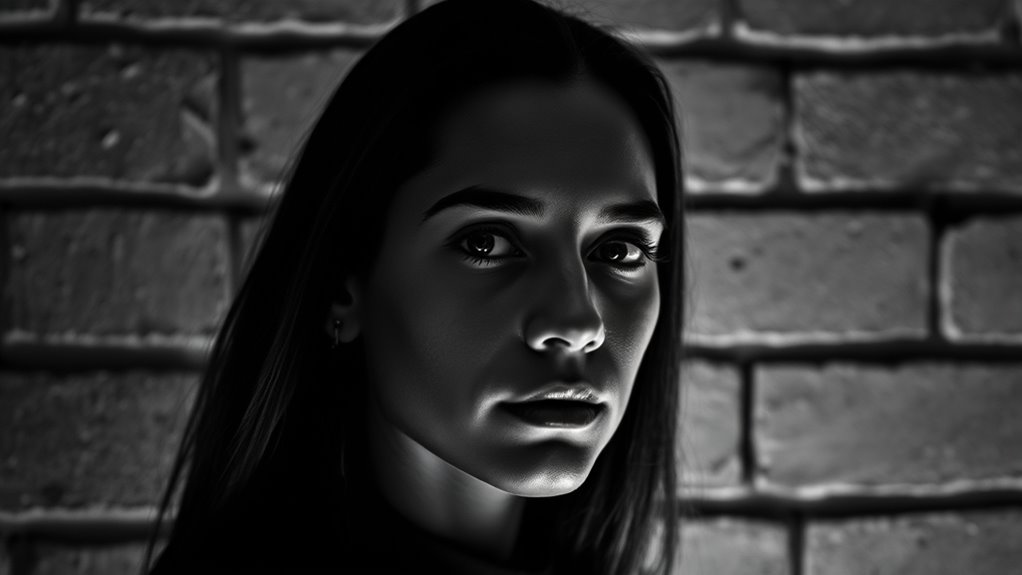
To create striking black and white images, mastering contrast and tonal range is essential. Your goal is to emphasize the differences between light and dark areas, which adds depth and drama. Pay attention to your color schemes; even in monochrome, subtle tonal shifts can dramatically impact the image’s mood. Using monochrome filters can help enhance contrast, allowing you to accentuate shadows or highlights intentionally. Adjusting these filters during post-processing lets you control the overall tonal balance, making your subject pop or creating a softer, moodier feel. Remember, high contrast isn’t always better—sometimes, a balanced tonal range produces more compelling images. Focus on controlling contrast and tonal variations, and your black-and-white shots will stand out with clarity and emotional impact. Understanding tonal range is key to creating images that truly resonate with viewers.
Choosing the Right Subjects for Monochrome

Selecting the right subjects is essential for creating compelling black and white images. Your subject selection greatly influences the emotional impact of your photos. Look for scenes or objects with strong shapes, textures, and contrasts that will stand out without color. Portraits, architecture, and natural details often work well because they convey mood and story through form and tone. Avoid cluttered or overly busy scenes that distract from the main focus. Instead, choose subjects that evoke emotion or tell a story through their form and presence. Remember, monochrome photography relies on contrast and texture to communicate feeling, so pick subjects that naturally lend themselves to these elements. Incorporating textile patterns or textured fabrics can add depth and interest to monochrome images. Thoughtful subject selection ensures your images resonate deeply and make a powerful visual statement.
Understanding Light and Shadow Dynamics

Understanding how light and shadow interact is essential for mastering black and white photography. Light absorption varies depending on the surface, affecting how tones appear in your images. Bright areas absorb little light, creating highlights, while darker surfaces absorb more, resulting in shadows. Recognizing shadow softness is vital; soft shadows indicate diffuse light, which produces gentle transitions, whereas harsh shadows come from direct, intense light, adding contrast. By controlling light absorption, you can emphasize certain elements and create depth. Observing how shadows fall and their softness helps you interpret scenes more effectively. This understanding enables you to craft images with dramatic contrast or subtle gradations, depending on your creative intent. Mastering these dynamics transforms ordinary scenes into compelling monochrome compositions. Developing a keen eye for light and shadow dynamics enhances your ability to express mood and atmosphere in your work.
Emphasizing Texture and Details
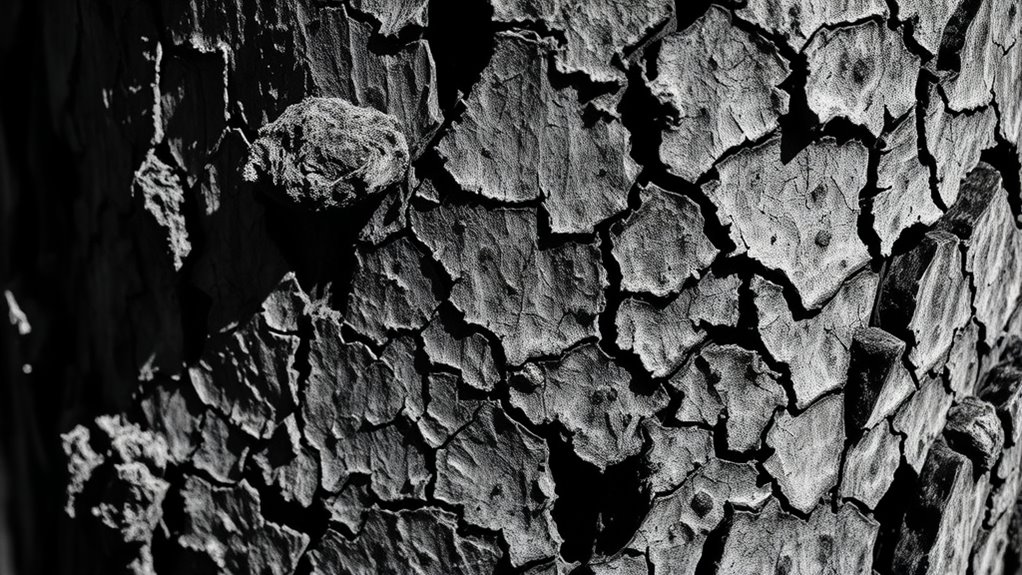
To make your black and white photos stand out, focus on highlighting surface variations and fine details. This draws viewers in and reveals the richness of textures that might otherwise go unnoticed. Enhancing these elements adds depth and dimension, making your images more compelling. Paying attention to visual balance and how different textures interact can further elevate your photographs.
Highlighting Surface Variations
Black and white photography excels at revealing surface variations by emphasizing textures and fine details that can sometimes get lost in color images. You can observe the grain structure of surfaces more clearly, adding depth and character to your images. By focusing on contrast and tonal shifts, you highlight subtle surface reflections that reveal the material’s nature and condition. These reflections can accentuate bumps, grooves, or roughness, making textures more tangible. Adjusting lighting helps you control how these variations stand out, drawing viewers’ attention to surface intricacies. Exploring different dog breed characteristics can also inspire how you approach textural detail in your photography. As a result, your black and white images become more compelling, showcasing the unique qualities of different surfaces through the interplay of light, shadow, and tonal contrast.
Capturing Fine Details
Capturing fine details in black and white photography requires paying close attention to the smallest textures and subtle nuances. Using film simulation can enhance the contrast and tonal range, bringing out intricate textures that might otherwise go unnoticed. Monochrome filters are also valuable tools; they help emphasize details by adjusting contrast levels and blocking out distractions. When you focus on sharpness and clarity, you reveal subtle surface variations—such as the grain of wood or the delicate veins in leaves—that add depth and richness to your image. Remember, the goal is to make every tiny element stand out without overwhelming the viewer. By thoughtfully applying film simulation and monochrome filters, you ensure your photos capture the exquisite, often overlooked, fine details that make black and white photography compelling. Additionally, understanding how cookie management impacts your website’s performance can help you optimize the viewing experience for your audience.
Enhancing Textural Depth
Have you ever noticed how certain textures seem to leap off the page in black and white images? To enhance textural depth, experiment with film grain and monochrome filters. Film grain adds a tactile quality, giving your photo a richer, more layered feel. Monochrome filters help emphasize contrasts, making textures pop. Use the table below to decide which approach suits your scene:
| Texture Type | Best Technique |
|---|---|
| Rough surfaces | Increase film grain |
| Smooth surfaces | Apply subtle monochrome filters |
| Complex details | Combine both for depth |
Incorporating sound vibrations can also influence how textures are perceived visually, adding another layer of depth to your images.
Utilizing Composition to Enhance Impact
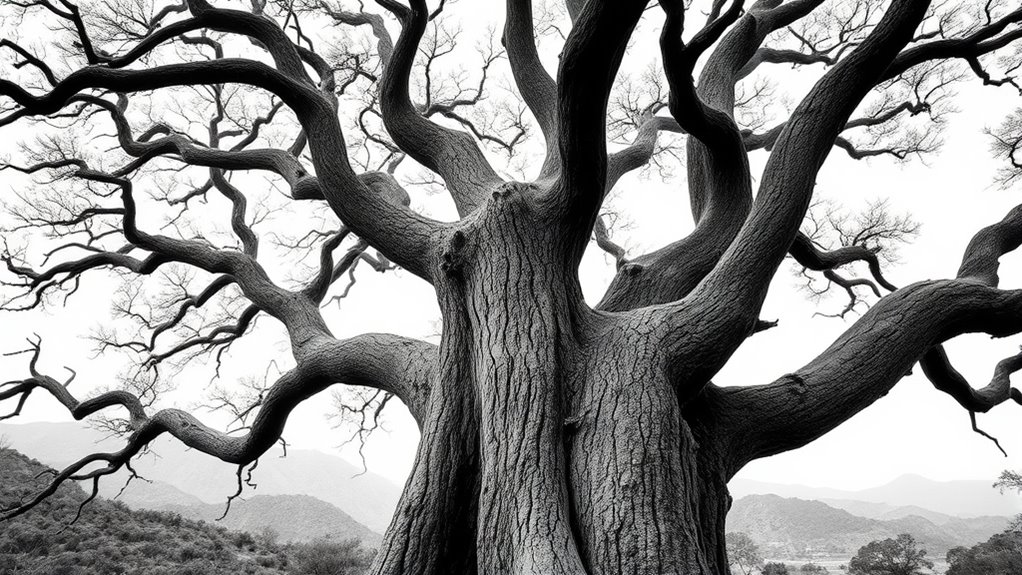
By thoughtfully arranging elements within the frame, you can dramatically increase the visual impact of your black and white photographs. Composition guides the viewer’s eye and emphasizes the subject’s emotional weight. Use principles like the rule of thirds to create balance, or lead lines to draw attention to focal points. Understanding color theory isn’t directly applicable in monochrome, but it influences how you interpret tones and contrast, shaping the mood through light and dark. Monochrome psychology plays a crucial role—high contrast evokes drama, while softer tones create serenity. By carefully considering these elements, you enhance your photo’s storytelling power, making the viewer feel more connected. Strong composition transforms simple images into compelling visual narratives that resonate deeply. Additionally, paying attention to interior placement and context can further elevate the impact of your images by framing your subject within a meaningful environment.
Post-Processing Techniques for Black and White Images
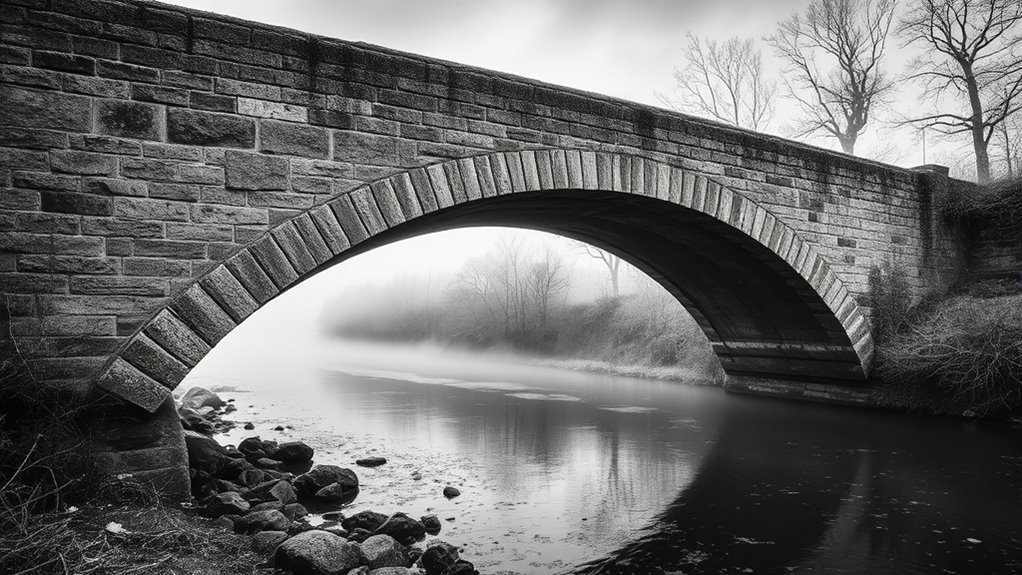
When editing black and white photos, adjusting contrast and brightness can dramatically improve the image’s depth. Using dodging and burning lets you emphasize specific areas and create more visual interest. Fine-tuning your tonal range guarantees the image has the right balance between light and dark for maximum impact. Incorporating exotic fruit blends into your editing process can inspire creative color grading and enhance visual appeal.
Adjusting Contrast and Brightness
Ever wonder how small adjustments to contrast and brightness can dramatically enhance a black and white image? These tweaks help you control the mood and depth by emphasizing key details. Use the monochrome histogram to guide your edits—aim for a balanced range of tones. Increasing contrast adds depth, while adjusting brightness brightens dull areas. To achieve better color harmony, make sure your highlights and shadows are well-defined without losing detail. Here’s a simple way to visualize how adjustments impact your image:
| Adjustment | Effect | Tip |
|---|---|---|
| Increase | More contrast, sharper | Watch for loss of detail |
| Decrease | Softer, muted tones | Avoid flat-looking images |
| Brightness | Lightens/darkens overall | Balance to preserve tonal range |
Tweaking contrast and brightness is key to unlocking your black-and-white image’s full potential. Paying attention to biodiversity principles can help you understand how subtle variations in tone and contrast can reveal intricate details and textures within your images, much like diverse ecosystems thrive through nuanced relationships.
Using Dodging and Burning
Once you’ve adjusted contrast and brightness to set the overall tone of your black and white image, you can further refine its depth and focus through dodging and burning. These techniques enable you to selectively lighten or darken areas, emphasizing textures like film grain or enhancing details in specific regions. For example, dodging can brighten highlights, making subjects pop, while burning deepens shadows for richer contrast. When working with color conversion images, dodging and burning help retain the natural progression from color to monochrome, adding subtle tonal variation. Use a soft brush and low opacity for controlled adjustments, ensuring a smooth, natural look. This process adds dimension, guiding the viewer’s eye and creating a more compelling black and white photograph.
Fine-Tuning Tonal Range
Fine-tuning the tonal range is essential for achieving a balanced and impactful black and white image. You can enhance contrast and clarity by adjusting highlights, shadows, and midtones. Using monochrome filters helps emphasize certain tones, creating mood and depth. To deepen your understanding, consider this table:
| Color Palette Effect | Impact on Tonal Range |
|---|---|
| Warm filters | Adds contrast to reds/yellows |
| Cool filters | Emphasizes blues/greens |
| Neutral filters | Maintains balanced tones |
| No filter | Preserves original grayscale |
Exploring Different Styles and Genres
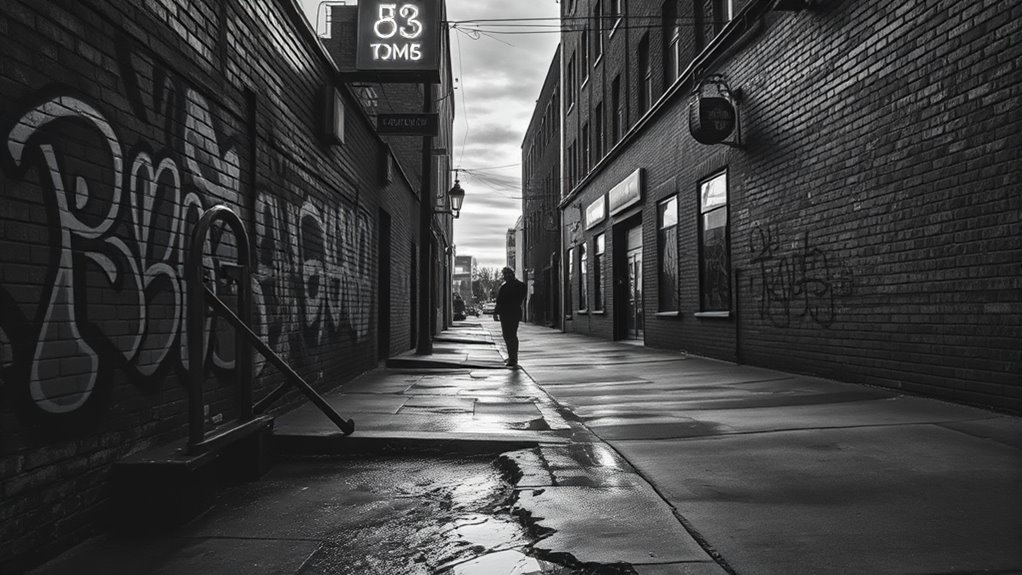
Have you noticed how black and white photography can dramatically shift in mood and style depending on the genre you choose? The key lies in selecting the right color schemes and digital filters. For classic portraits, you might opt for high-contrast tones to emphasize emotion, while street photography benefits from gritty, desaturated looks that capture raw energy. Landscapes can be transformed with subtle gray scales or bold monochromes, creating different atmospheres. Digital filters allow you to experiment with textures and contrast, giving each genre its unique character. Whether you’re aiming for timeless elegance or edgy realism, understanding how different styles and genres respond to tonal adjustments helps you craft images that resonate with your vision. Explore these options to *free* endless creative possibilities.
Tips for Shooting in Black and White on Location
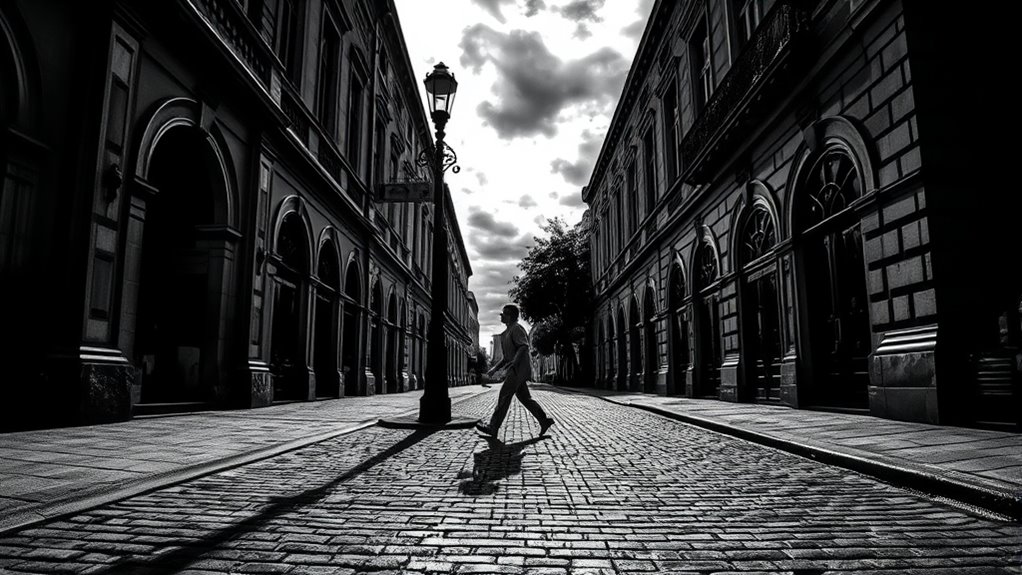
Shooting in black and white on location requires you to pay close attention to lighting and contrast, as these elements become even more essential without color to guide the eye. To achieve striking images, focus on controlling shadows and highlights, which emphasize texture and form. Proper color calibration on your camera ensures accurate tones, preventing muddiness in monochrome. When selecting equipment, opt for lenses that enhance contrast and sharpness, and consider filters like red or yellow to deepen blacks and lighten whites.
Here are some tips:
- Use natural light during golden hour for softer shadows.
- Adjust your camera’s settings for high contrast.
- Rely on equipment selection that enhances tonal range.
- Preview images in monochrome to refine composition and exposure.
Frequently Asked Questions
How Can I Effectively Convey Emotion Through Black and White Photography?
To effectively convey emotion through black and white photography, focus on emotional storytelling by capturing genuine moments that resonate with viewers. Use tonal contrast to emphasize key elements and evoke mood—sharp differences highlight intensity, while softer tones create subtlety. Pay attention to expressions, gestures, and lighting, as these details help communicate feelings. By combining strong storytelling with well-managed tonal contrast, you can create powerful images that evoke deep emotional responses.
What Are Common Mistakes to Avoid When Converting Color Images to Monochrome?
Think of your photo as a story with a clear message. When converting to monochrome, avoid common mistakes like neglecting to fix color cast, which can create unnatural hues, or ignoring poor contrast, making your image flat and dull. You want the final shot to have depth and clarity. So, pay attention to these details, ensuring your black and white image truly captures the emotion and essence of the scene.
How Does Film Black and White Differ From Digital Processing Techniques?
When comparing film black and white to digital processing, you notice that film often has natural grain that adds texture and depth, creating a timeless feel. Digital techniques, on the other hand, rely on filters to mimic this grain or enhance contrast. You can control the look more precisely with digital, but film’s organic qualities often give a richer, more authentic experience.
Can Black and White Photography Work Well for Abstract or Minimalist Subjects?
You can definitely use black and white photography for abstract or minimalist subjects. It works well because it emphasizes contrast and focus, helping your viewer notice textures and shapes without the distraction of color. By simplifying the image, you draw attention to the core elements. This approach enhances the visual impact, making your abstract or minimalist work more striking and compelling through the strategic use of contrast and texture emphasis.
What Equipment or Accessories Are Recommended for Shooting Monochrome Images?
For shooting monochrome images, you should consider using monochrome filters to enhance contrast and details, making your black and white photos more striking. Investing in black and white lenses can also improve image quality by reducing color fringing and maximizing tonal range. Additionally, a good tripod helps stabilize your shots, especially in low light. Together, these accessories help you achieve crisp, compelling monochrome images with depth and clarity.
Conclusion
Now that you’ve got the tools, go ahead and capture stunning black and white images. Remember, mastering contrast, light, and texture makes your photos pop—like a vintage film reel coming to life. Don’t be afraid to experiment with different styles or shoot on location, even if it feels like stepping into a different era. Keep practicing, and soon you’ll be creating monochrome masterpieces that stand the test of time, just like those classic photographs from the days of film.









